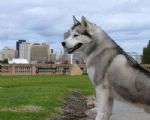SIBERIAN HUSKY
The Siberian husky (Canis lupus familiaris) is a gorgeous dog that was originally bred in Siberia. It is an average sized dog that has a very thick coat of fur to help it withstand the cold habitat it originated in. These working dogs are kin to the Spitz family, and it is instantly noticed by some very specific breed characteristics. Siberians have very thick fur coats, a tail that is in the shape of a sickle, high sitting ears and markings that are clearly Husky.
Considering they were originally brought up in the Siberian Arctic, the husky breed had to learn to be highly energetic and tough. The originally were bred by the Chukchi in Asia as sled dogs. They would haul large loads across some of the worst weather around. The Husky then moved on to the wilds of Alaska to participate in the Gold Rush and eventually found homes across North America.
Though they were meant to come to America as working sled dogs, they ended up gaining traction as family dogs. The breed also became quite popular on the show dog circuit.
As sled dogs, however, they are just as popular. These tough working dogs are able to work long and hard on a minimum of sustenance. They can haul people and equipment for long distances as a team.
Another interesting note about the Siberian Husky is that it is considered one of the oldest breeds around. The name is derived from Esky, which is short for Eskimos and their canines.
Siberians are known for being capable helpers. They were key to the early tribes moving to terra incognita and even helped to ensure the safe travel of military men in searches for the North Pole.
The Siberian Husky also dominated the “All Alaska Sweepstakes” dog race. The breed was leaner and quicker than the heavy dogs normally used.
Specifics about the Siberian Husky Breed
Siberian huskies are referred to in a number of ways. They are called Chukcha, Chuksha and even Icee dogs. The males grow to around 75 pounds and the females about 60. They stand around 24 inches and 22 inches respectively. Their coats are soft on the outside but thick and coarse on the underside. This double coating keeps the dog warm. They are usually black and white in color, but they can be other colors too. A litter yields about six pups and the average Siberian lives about 14 years.
The coloration of huskies are extremely variable but the most common is black and white. After that, they are usually red and white, gray and white and other similar patterns. The face is usually marked as well as the very end of the tail. White paws and legs are common. The cool thing about Siberians is the variations on the face. Some have a raccoon like face while others simply sport specs. They look much like other Spitz breeds such as the Malamute and Samoyed. Many people will mistake a Siberian for a wolf if uninformed and caught by surprise.
The Siberian has some very unique eye color combinations. They may have eyes colored deep blue, dark blue, light blue, brown or even a rust color. They may be different colors or may be half and half. These various combinations are due to heterochromia which is common in the breed. It is considered acceptable even when showing the dog. In truth, the eyes are part of what makes the breed so striking and beautiful.
The Siberian husky tails are very thickly covered in fur and they like to use this tail to keep their nose warm in the winter. Seeing them curled up with the tail covering their noses is common.
Siberian Husky Temperament
From a behavior standpoint, the Siberian Husky is a great and intelligent breed. They are close and affectionate, but they spend plenty of time alone as well. They especially love to be around other canines, probably due to their history of being bred as team dogs. This history also ensures the dog will run and run quickly before you know what happened if you let them off the leash. Make sure you are in a confined space before letting them run free. Even if the area is fenced in, know that the Siberian is a great digger. They can climb and dig with the best breeds out there and find a way out of most fences. For this reason, you have to really invest in a great housing area that gives them room to run their energy out, but still keep them close to home and safe.
From an intelligence standpoint, the Siberian is a great breed. They take to training very well and get bored easily if you do not take the time to stimulate their brains. To ensure a happy Siberian, you are going to have to invest some time and energy. They are not going to sit around and lick their paws all day!
